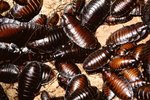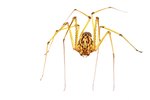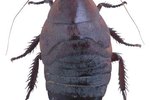
By the time Marianne C. Dominguez of the University of California at Davis finished researching her award-winning paper on the history and biology of the cockroach, she'd become an unapologetic admirer of this much-reviled insect. The lowly roach was “an amazing creature worthy of respect in the tree of life,” she concluded, a bug designed by nature to adapt so successfully to its environment that it has survived -- virtually unchanged -- for hundreds of millions of years.
About Cockroaches
At least 3,500 species of cockroach are known to exist worldwide, but the U.S. is home to about 55. These bugs come in many different colors and sizes, but what they have in common is a flattened body with three segments -- head, thorax and abdomen -- and six long legs. Their shape allows them to scuttle into even the narrowest cracks and crevices, and those found indoors prefer warm, dark, moist environments such as kitchens and bathrooms. They're nocturnal so if you see them in daylight, they've either been disturbed -- or you've got an infestation so serious that there are more bugs than spaces for them to hide in. They'll eat anything people eat plus a lot more.
The Fossil Record
Fossil records of the ancestor of the modern cockroach go back 300 million years, but the bug we know and hate today has changed very little since the Carboniferous period 250 million years ago. Cockroaches have survived many extinction events, including the end of the dinosaurs, seemingly unscathed. As for their presence in human habitats, the Trust for African Rock Art believes the earliest cave paintings were created between 15,000 and 33,000 years ago. That's probably when roaches discovered that it took much less effort to co-exist with humans in a sheltered cave environment, eating what we inadvertently left behind, than to forage in the wild. They've been sharing our homes, and food, ever since.
Adaptations for Survival
The conclusions of a study that made headlines around the world after being published in "Science" in May 2013 came as unwelcome news to people battling roach infestations. Researchers found that many German cockroaches, one of the most common species in the U.S., appear to be taking evasive action against poisons used to kill them. Glucose, a plant sugar that these roaches used to love but now avoid, has traditionally been used to lure them into roach traps. Entomologist Coby Schal, one of the study's authors, believes the glucose in roach poison has reactivated an ancient but long-dormant gene for glucose aversion. In coming years, after the cockroach genome has been fully mapped, this theory will either be upheld or debunked, Schal says.
Fun Facts
Cockroaches can run faster than any other insect. The many sensory organs on their legs make them aware of even the slightest hint of danger, allowing them to make their escape within 40 milliseconds. If you want to kill a roach, don't decapitate it, because the headless body can live on for several weeks, and the disembodied head for several hours. Roaches forage alone, but when they find something tasty, they send out restaurant reviews to their friends and relatives, probably by releasing pheromones, which is why you often see a lot of them feeding together. Texas is the cockroach capital of the U.S. -- it's home to 32 different species.
References
- Texas Agricultural Extension Service, The Texas A&M University System: Cockroaches, Recognition and Control
- Purdue Extension: History of the World: Cockroaches were there
- National Geographic: Madagascar Hissing Cockroach
- University of California at Davis Prized Writing: The Cockroach; Marianne C. Dominguez
- Science Daily: Science News: Cockroaches Share 'Recommendations' of Best Food Sources, Research Finds
- Behavioural Ecology and Sociobiology: Collective Foraging Decision in a Gregarious Insect; Abstract; Mathieu Lihoreau at al; October 2010
- Huffington Post Science: Ancient Insects: Prehistoric Cockroach-Like Bugs, 300 Million Years Old, Recreated in 3D
- Time Science and Space: Mutant Cockroaches Have Learned to Evade Sugar Traps
- Trust for African Rock Art: Rock Art in Africa
- Science: Changes in Taste Neurons Support the Emergence of an Adaptive Behavior in Cockroaches; Coby Schal et al; May 2013
Resources
Photo Credits
-
Hemera Technologies/PhotoObjects.net/Getty Images



